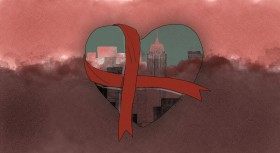Many Indonesians are sickened by the blurring of women’s bodies on TV, except the executives of Indonesian Broadcasting Commission (KPI) and the Indonesian Child Protection Commission(KPAI), which have both supported heavy censorship on TV.
But both KPI and KPAI love to point out that they are not the one who did the censorship. The decisions to blur Scarlett Johansson’s cleavage, Shizuka’s chest, Sherlock Holmes’ smoking pipe, and the entire torso of Papuan swimmer Margaretha Herawati lie in the hand of the respective TV stations, they claim. This means complaints and questions should be addressed to the stations. Instead, the commission is keen to investigate other aspects, for example, why would a television channel interview a person instead of exclusively showing the race from long distance? Or could the reporter have at least asked the athlete to cover up first before the interview?
Their second defence is that censorship by blurring is not done by TV stations in Indonesia only, but in other countries too, including non-Muslim countries. Thai television censorship is stricter than ours, even blurring shoes soles, men’s nipples (at least one can’t accuse them of gender bias), and a glass of beer (which is supposedly okay in Thailand). China is also fond of cropping out cleavages – and don’t forget it’s infamous bans on time travel as a drama plot. Indeed, this is a difficult topic to explore. There are not many analysis and opinion pieces on this issue, despite the significant ridicule and controversy the KPI’s policy has triggered.
Early this year, fellow Magdalene writer Dea Safira Basori had her Facebook account suspended after she posted pictures of topless Indonesian women from early 20th century. The incident happened around the same time that Telkom blocked Netflix, Tumblr was included in the “Positive Internet” blacklist, and Indosiar blurred the bodies of Putri Indonesia contestants. The suspension of Dea’s account could be the combined result of Facebook’s automatic censorship and reports from people who were not pleased with her project. The censorship policy of Facebook’s sister platform Instagram irks many feminists in the West, as it targets women’s bodies (including unshaved bikini line and cancer survivors’ breasts), but is lenient of violent pictures and racist memes.
Ironically, it is easier to figure out Facebook/Instagram than the KPI. Facebook and Instagram do not want to be banned in any region and country for “providing pornography.” They are not in the business of debating whether a bloodied pants or pictures of Dutch East Indies women are pornography or not. They’re in the business of getting as many users of possible and staying out of trouble. Strangely, Internet regulators worldwide are also more scared of women’s crotch than of hate groups.
The most popular theory on KPI is that it is full of religious conservatives. According to another media watchdog, Remotivi, KPI is more obsessed with morality issues than on other things that should be the concern of a broadcasting commission, like journalism integrity, correct age classification, and technical regulations.
Several years ago KPI was established out of two concerns. First, the tycoon-politician owners of television channels could use their stations to broadcast all their propaganda. Second, during the New Order, centralized television contents eroded local culture and ignored local talents. KPI would ensure that television channels give space for local programs while preventing stations from abusing news and talk shows.
The first objective is neglected, as television channels in Indonesia dedicate a big chunk of their space to praise their owners. Perhaps KPI has contacted them about it, but we haven’t seen television channels blur the face of their tycoon-politician owners. So it seems that television stations take more seriously KPI’s warning about animated female squirrel in bikini.
As a member of the “kelas menengah ngehe” (awful middle class), I am not too happy either with the local content. I understand that the Jakarta-centric television is out of touch with Indonesia’s diversity. But when the local content is another religious program or a half-baked wayang sketch (or worse, a commercial masquerading as a talk show), I’d rather return to centralization. It’s all Jakarta for the rest of the day anyway.
I am fine with censorship. HBO, Fox, FX, and other cable channels in Southeast Asia seem to apply censorship to nudity and graphic violence, and they don’t seem to disturb my viewing experience or disrupt the story. Censorship on free-to-air channels, meanwhile, with blurring of cigarette, cleavage, and abrupt cuts are both distracting and annoying.
More seriously, instead of editing cartoons and movies, the TV channels should exercise their discretion in their treatment of news. It is not a practice for newscasters in Indonesia, for example, to warn viewers if their reports contain disturbing materials. If anything, it seems TV news compete for the goriest stuff. And what about those awful talk shows full of sexism, misogyny, and homophobia?
If KPI only barks but does not bite – as it claims to do – then why do television channels blur women bodies in the name of “playing it safe,” while preferring the “crude” in presenting news and talk shows?
I am not sure if KPI commissioners are overtly religious people, but the similarities of censorship in Indonesia, Malaysia, Thailand, and China show that one doesn’t have to be religious to be all for censorship. Being a conservative is enough. Or pandering to conservatives, in the case of Facebook and Instagram.
Both Indonesia and China also rely on vaguely worded laws (the so-called “rubber articles” in reference to their elasticity) so that media providers will do everything to avoid a complaint, without knowing clearly its rights and limitations. China does not even have an official age-rating system, which means it often bans any film without clear reason.
It seems that censorship policy in Asia and elsewhere run on a platform of hypocrisy: hating the nature of women’s body while ogling over it as the same time. While Chinese TV crops out cleavage, state-run websites engage with international audience by sexualizing women.
Perhaps the bigger question is: how can we fight hypocrisy on television?
Read Mario’s piece on Mother Theresa’s sainthood.









Comments